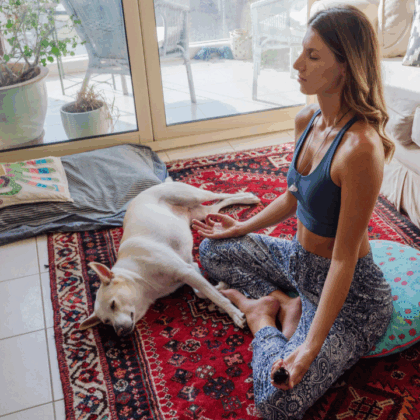A lot of dog training is about finding ways to communicate to the dog what you want them to learn. Whether that’s a fancy trick or a rock steady stay, we work on position, precision, duration and more. But when it comes to Really Real Relaxation, we end up moving past skills the dog needs to master, and we end up face to face with biology and our own ability to relax.
If you want your dog to experience relaxation, you must first master it yourself. This isn’t about fairness or taking turns—it’s about biology. Your dog’s nervous system is constantly calibrating itself based on your internal state, whether you’re aware of it or not. Some dogs are better at tuning out their handler’s emotions while others really take your behavior to heart.
Research shows that emotional contagion between dogs and handlers strengthens over time, creating increasingly synchronized physiological responses. Your dog isn’t just reading your body language; they’re literally attuning to your autonomic nervous system. When your stress hormones rise, theirs follow. When you achieve genuine calm, they can access it too.
The tricky part is that dogs can distinguish between faked calm and authentic relaxation. You can’t fake your way through this. Sitting still while internally churning with worry, frustration, or mental chatter won’t fool your canine pal for a second. They’ll remain alert because your system is broadcasting “not safe to relax.”
For many handlers, learning to genuinely relax is harder than teaching any traditional obedience command. We’re often carrying stress from work, relationships, financial concerns, or simply the mental habit of constant doing. Being a human often means doing, doing, doing. Sitting quietly without agenda or activity can feel foreign, even uncomfortable. It is weird just being.
Yet this is exactly what we’re asking of our dogs when we want them to experience RRR. We’re asking them to be present, to let go of vigilance, to trust that this moment is safe enough for relaxation. If we can’t model this state, how can we support them in this practice?
If you find this really challenging, consider working on your own awareness without your dog. For many handlers, a great way to begin is the simple practice of deliberately being conscious of your breathing. Notice as you breathe in, gently hold that breath, breathe out, another gentle hold before inhaling again, and so on. Soften your jaw, unclench your fingers and toes, blink slowly, and begin to notice any tension in your body. This is not about perfection, this is about practice.
Your dog will notice the changes in you, possibly before you do! They’ll begin to mirror your state, gradually learning that when you’re truly calm, they can be too. And yet, even if you are relaxed, this does not force the dog to be relaxed. It simply sets the stage so that the choice to relax is possible for the dog.
Remember: you can’t give what you don’t have. Your genuine relaxation is a powerful gift you can offer your dog. Take time to cultivate the art of spending some time as a human being, not a human doing. Your dog will thank you.

